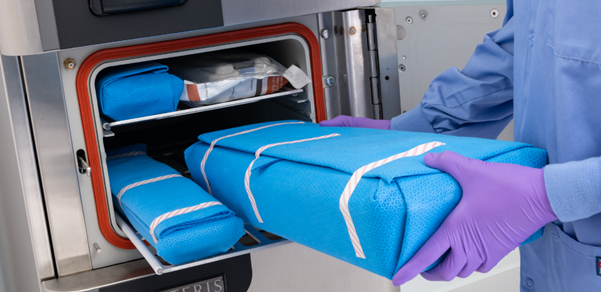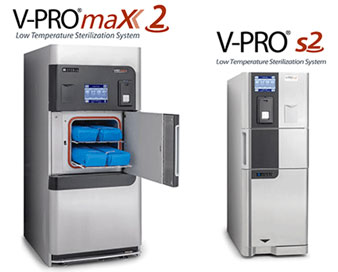Knowledge Center
June 30, 2023
Comparing Options for Rapid Turn / Immediate Use Sterilization
Supporting a Compliant Approach When You Need To Sterilize a Device Quickly
Surgical procedures do not always go as planned. An instrument arrives in the operating room (OR) with a tear in the sterile packaging, or a unique instrument is dropped, and the procedure cannot continue without it. Mistakes happen, and undeniably there are instances where a device needs to be reprocessed faster than normal, in some cases, immediately.

The lack of sufficient inventory or late delivery of instrumentation should not be considered an emergency.
To accomplish this, you will often hear two terms used: Rapid Turn and immediate-use steam sterilization (IUSS). Rapid Turn is often used in the Sterile Processing Department to identify instrument sets needed the same day, moving them ahead in normal queue. IUSS, formerly known as “flash sterilization,” is defined in the standards as the shortest possible time from an item being removed from a steam sterilizer to the aseptic transfer onto the sterile field1.
The IUSS process is intended to sterilize a single instrument for emergencies only. There was a time when facilities went beyond the original intent making IUSS more common as opposed to an exception. Whatever the reason causing the need for a device to be processed immediately, it has been established by organizations (like Joint Commission) who perform audits of healthcare facilities that IUSS should not be used except in the case of a true emergency.
What do the Standards Say?
Facilities should always follow evidence-based guidelines and national standards when performing IUSS.

Organizations, including the CDC, AORN, and AAMI, agree that IUSS should only be used in emergencies and kept to a minimum.
Why? Consider the risks associated with IUSS, which can include:
- The lack of timely biological indicators (BI) results monitoring performance
- Compliance/adherence to manufacturers IFUs for cleaning
- Cooldown period required after sterilization, with possible risk of staff or patient burns
- Minimal sterilization cycle parameters (i.e., time, temperature)2 which do not meet device instructions for use (IFUs)
However, there are emergency situations where IUSS may be the only option, and facilities should specify what constitutes an emergency in their policy and procedures. Staff should understand evidence-based guidelines and undergo competency verification to ensure the sterilization process used is successful.
It is important to follow the device or the sterilizer equipment manufacturer’s written IFUs for reprocessing, including confirming the specific cycle’s time and temperature are approved for that device. The same critical reprocessing steps (cleaning, decontamination, and transporting sterilized items) must be followed regardless of the specific sterilization cycle employed; a safe process does not include shortcuts or work-arounds4.
The IUSS process must always be documented. Documentation includes, but is not limited to, load and cycle identification (time, temperature, and load contents), BI results, and case information (operating surgeon, patient, and the reason for IUSS).
Each instance of IUSS will likely go under review during an audit. Credentialing organizations like the Joint Commission and DNV will likely review IUSS logs during every inspection. Typically, auditors check for completeness of documentation to ensure IFUs were followed and that the cleaning, decontamination, and inspection steps were entirely performed prior to IUSS. If an auditor identifies a trend that IUSS is performed frequently, they will also likely review a facility's processes and policy, questioning if lack of inventory, and not a true emergency, resulted in the need to perform an IUSS cycle.
Options When You Need to Sterilize an Item Quickly
What options exist when a hospital or ambulatory surgery center (ASC) needs to sterilize an item quickly?
Rapid Turn Terminal Sterilization
So, how can you remain compliant when you need a device or instrument quickly sterilized and do not have the time for a standard steam cycle?
To achieve terminal sterilization in Steam requires a standard cycle time. A typical standard cycle time for 4-minute sterilization and 30-minute dry time is approximately 1 hour total. Some IFUs require a 45 minutes or longer dry time, which lengthens the process.
In addition to the cycle and dry time, adequate cooling time can require two (2) hours or more5, depending on the conditions and package contents. Considering those times, it is easy to understand that a delay of hours is not acceptable when a device is needed quickly.
Vaporized Hydrogen Peroxide (VH2O2) Low Temperature Sterilization. VH2O2 sterilizers offer fast cycle options and ensure terminal sterilization in as little as 16 minutes for properly prepared medical devices. With VH2O2, no cool-down time is necessary because VH2O2 sterilization operates at a low temperature. Personnel can use devices or instruments immediately following their policies and procedures for release.
What if the device IFU does not specifically mention VH2O2 Sterilization?
If the device falls within the claims in the VH2O2 sterilizer’s indications for use, the VH2O2 sterilizer may be used for reprocessing. Customers are encouraged to reference the sterilizer’s Device Compatibility Matrix for a full list of compatible devices. The decision to process these devices with a sterilizer, such as V-PRO Low Temperature Sterilization Systems, would be the type of informed decision recommended by AAMI ST81, pg. B6.
Skip the risks of IUSS and protect the safety of your patients, staff, and devices by using VH2O2 Fast Cycles. VH2O2 sterilization offers the peace of mind you need during rapid turn sterilization.
Explore V-PRO Low Temperature Sterilizers

Article References
2, 3, 4 Flash Sterilization – Guideline for Disinfection and Sterilization in Healthcare Facilities (2019), CDC https://www.cdc.gov/infection-control/media/pdfs/guideline-disinfection-h.pdf?CDC_AAref_Val=https://www.cdc.gov/infectioncontrol/pdf/guidelines/disinfection-guidelines-H.pdf
5 ANSI/AAMI ST79:2017, Section 10.3.1 – Unloading sterilizers having a chamber volume larger than 2 cubic feet.
6 ANSI/AAMI ST81 Sterilization of medical devices—Information to be provided by the manufacturer for the processing of resterilizable medical devices








